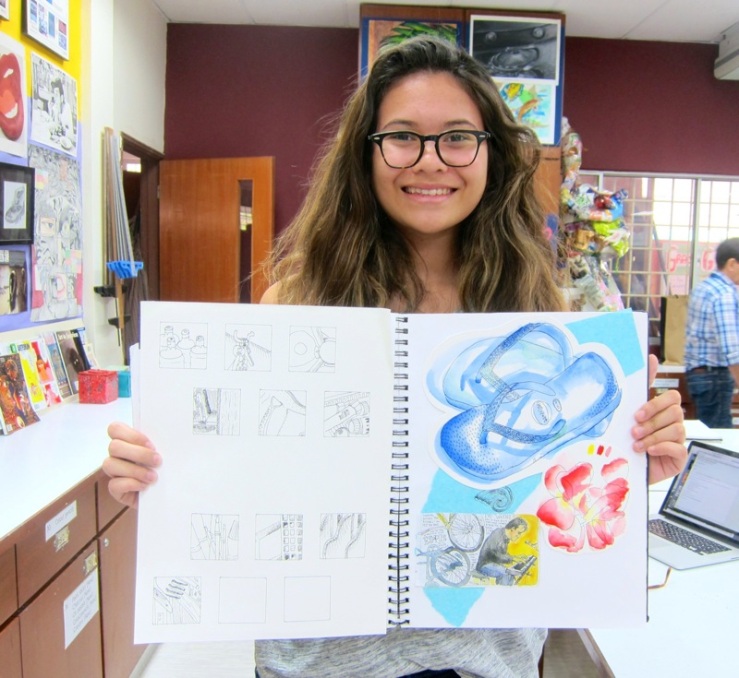
I don’t have loads of fond memories of teachers in high school. And most of the art teachers were especially forgettable. And as you know, the monkey voice in my head makes sure I still retain some ambivalence and self-doubt surrounding my own position as an artist and as a teacher. Nonetheless, I’ve agreed to spend a week with high school students at the International School of Kuala Lumpur and went with a few sketchy ideas and an open mind.
ISKL is a terrific school. It has students from fifty countries, all studying in English, and they go on to top universities in the US and Europe. Great art schools too, RISD, Cal Arts etc. They have lavish resources, a dark room, a theatre, art classes three times a week, a swimming pool, sports fields, a great library — so much more than Jack had in the NYC public schools system.
Whatever they do in life, the school is giving them a solid and broad base of culture. These are well-behaved kids, prepped for success, eyes drooping from after-school tutoring and late-night study sessions. Their parents are diplomats, engineers, top executives in global companies, or the cream of Malaysian society. Several have the talent and drive to get into a great art school, but their parents want them to study economics or law. Still, they are not hectored drones hell-bent on success. Just good kids who need to be goaded to take some risks.
Which was why I was there.
It took me a few false starts to figure out how to proceed. I began with a lecture with almost 100 slides, selling them reason after reason for how great illustrated journaling could be for their lives. I repeated this mistake in three different classes that day.
I went home the first night, still half dead from jet lag, dismayed by the realization that I’d become one of those droning teachers I hated in high school, telling kids what was good for them, urging them to follow my example, using incomprehensible, made up jargon, telling them what was wrong with thinking any way but my own. I’d behaved like I was doing a presentation back at my ad agency, selling my ideas hard, rather than being empathetic, rather than understanding where I was or what they needed. I’d talked so much that first day, we hadn’t even had time to do any drawing.
It’s one of the problems with being an ‘expert’, when you aren’t really sure what your expertise is or how it’s useful. It takes time to recut your experience to suit the current situation, to figure out how what you know night be of service, If you come in hellbent on asserting your expertise or tone-deaf and presenting your same old stump speech, you risk boring or alienating the people you wanted to help. You have to become expert in being an expert. In part, that means, knowing what you don’t know.

One idea I’d sold my host Ian on, was that we could get the kids to create a whole bunch of great sketchbook pages documenting the stories of the school. They could interview the staff in the kitchen, draw the equipment in the gym, sketch the poses people struck while studying in the library, and at the week’s end, we’d have a great collaborative project that he could curate somewhere. It wasn’t a bad idea but it didn’t set the kids on fire. I was excited to poke into all corners of the school, but these kids spend all day all year there and there were few revelations left, despite my exhortations to discover a new way of seeing. We did spend a couple of days drawing the turtles in the pond, the band rehearsing, the lost and found. But I realized that this very loose assignment was too ambitious and not sufficiently attuned to the way the kids think.
This was not like teaching adults. It’s not the self-motivated atmosphere of Sketchbook Skool. Kids aren’t in high school because they want to be, they’re not looking for ways to realize their potential. They’d much rather hang out with their friends or play video games. So they need you to focus them, tell them what you expect them to do, and make it finite. The older kids are working towards their International Baccalaureate, sort of like AP classes in the US, so they need final projects for their portfolios, not meandering explorations of the recycling cans or the locker rooms. My first days of loose experimentation in creative freedom left them lost, afraid of doing wrong and wasting precious time.
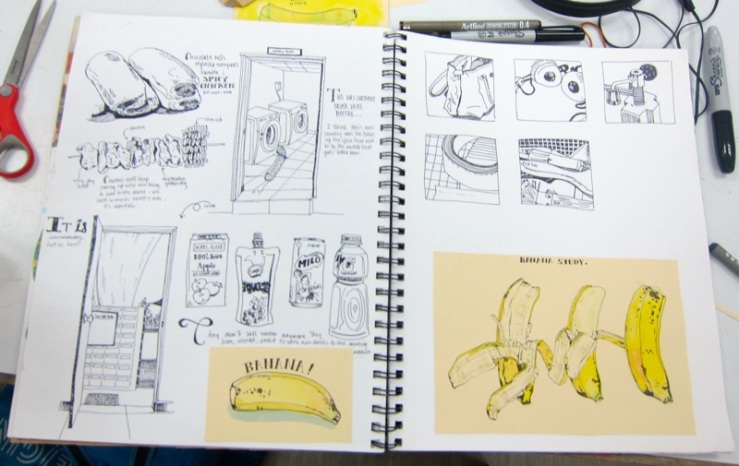
Next we gave them more specific assignments. Draw six things that are round but very different sizes, draw them the same size and arrange them evenly across the page. Draw a stack of books you’ve read in the library, giving them dimension, paying attention to the letterforms. Interview and draw one worker in the kitchen. Draw the place you’ll miss the most after you graduate. This was better, and they certainly did the assignments uncomplainingly, but much of the work was still sketchy and lacked passion.
Next step was to tone down all the demands of illustrated journaling, rather than insisting on 1. interesting drawings, 2. confident line work, 3. insightful, witty stories in 4. nice calligraphy, with 5. good composition and 6. a well laid-out page — let’s just get excited about drawing.
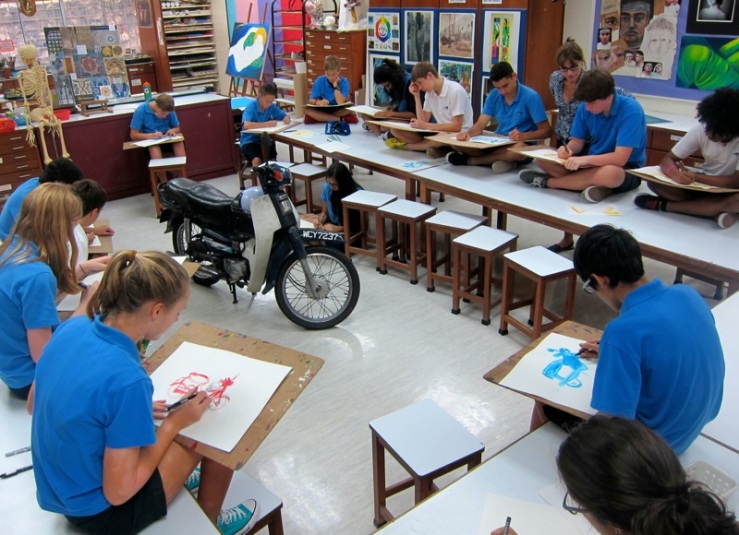
Things took off when I demonstrated how to do a technique I showed in Sketchbook Skool, I call “slow/fast”. First we drew a one-minute gesture drawing with a fat brush dipped in watercolor, followed by a carefully observed, detailed pen drawing right on top of the initial study.
We wheeled a motor scooter into the middle of class and sat around it drawing. The kids were silent, lost in drawing, and the results were awesome. The teacher told me, “This is usually my most unruly and disruptive class and I have never seen them so engaged. And I love the drawings they did. Many asked if they could keep working on them in their free time.”

I tried the same Slow/Fast technique with another group, dividing them into pairs and having them pose for each other. The portraits were a huge leap from the work they’d done early in the week, individual, well-observed and alive.

Next we made a dozen or more squares on the page, then drew little snapshots of random scenes through a viewfinder, like a contact sheet or scenes from a movie. Again, the drawings were carefully observed and lively, the compositions were interesting and fresh. Initially we knocked out each little drawing in a minute or two, but then many of the kids went back and added more detail and color.
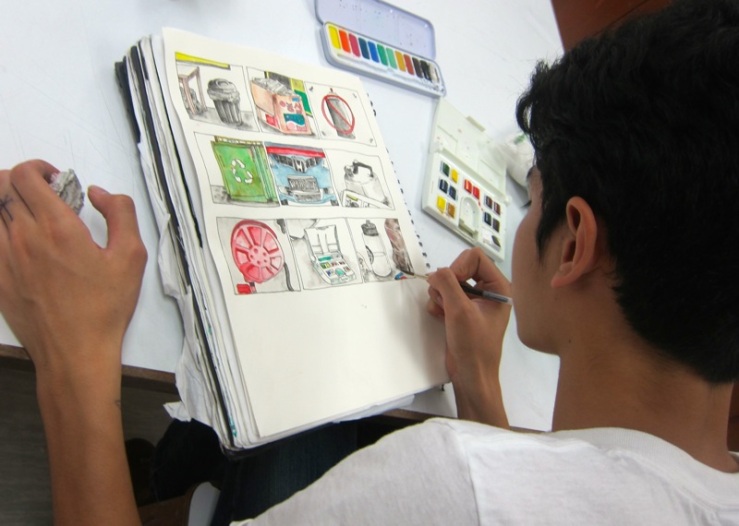 I also taught through example. I shared the pages I had made outside of class drawing around Kuala Lumpur, I passed around old sketchbooks, showed images I had made over the years. I did a lot of drawing, participated in the exercises, then walked around pointing things out here and there, try this, consider that.
I also taught through example. I shared the pages I had made outside of class drawing around Kuala Lumpur, I passed around old sketchbooks, showed images I had made over the years. I did a lot of drawing, participated in the exercises, then walked around pointing things out here and there, try this, consider that.
On the last day, I hauled out my slides and books again, and this time the response was different. Now they loved drawing and it made sense so we could delve deeper into conversations about layout, expression, inspiration, technique, possibilities.
My biggest lesson was that you first need to show students how it feels to love making art. You need to have that momentary flash when you see why it’s so great. It could be the deep meditative experience that comes from really concentrating and going deep. It could be that moment when you pull out of that daze and look at what you have made and are blown away. Just doing one great drawing give hope. Even if the next one sucks, you know you can do it because you did it once. And when you have that knowledge, you have secure ground to build on.
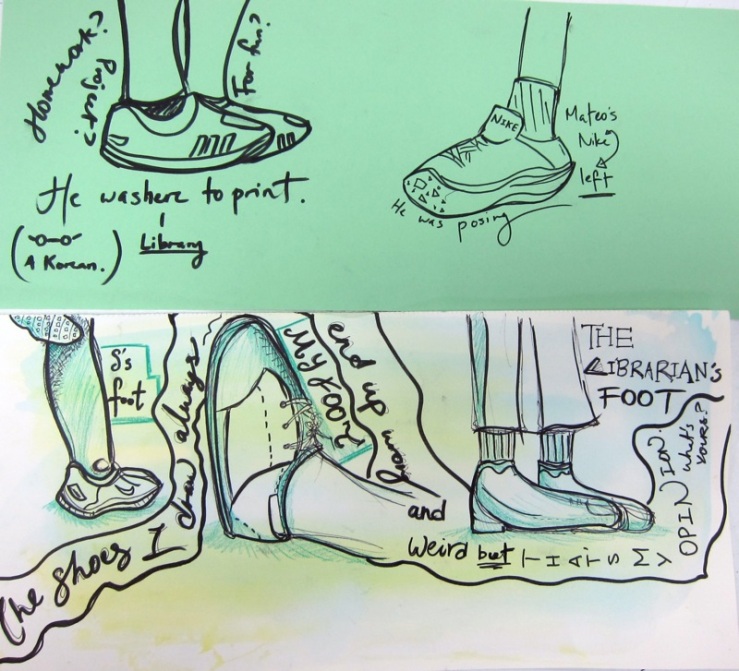
Early in the week, one girl made several really great pages but I would hear her muttering to herself or her neighbor how much she sucked at drawing. Then I saw that she had written, in graceful swirling letters, right on her page, that she thought this drawing was awful and that she was no good. I explained how untrue I thought this was but also how, by asserting it over and over, she was creating a self-fulfilling process. We kept pushing ahead with more experiments that would distract her monkey mind and by the week’s end, she showed me drawing after drawing with pride.
I felt good but I wasn’t really sure if I’d really made an impression on the classes. So many of these kids are reserved and polite and not effusive and the monkey was still wondering if all this time and travel and work had been worthwhile, for them or for me. On Saturday afternoon, I went back to my desk to pack up my stuff and there on my laptop was a card. On the cover was a lovely watercolor portrait of me and inside the students had written (neatly lettered and beautifully composed) how much my time had meant to them, how much they had learned, how they now embraced risk and mistakes and how grateful they were I had come to their school.
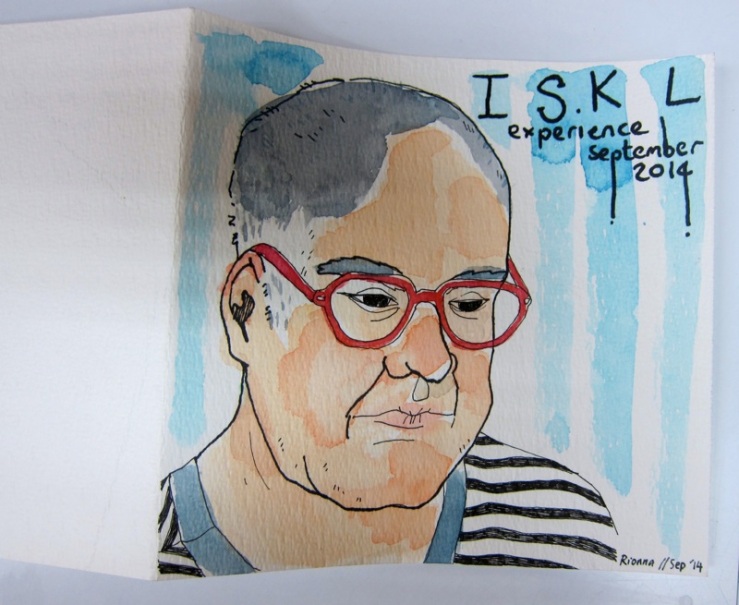
It felt like every corny movie about teaching I’ve ever seen, Mr. Chips, Mr. Holland, Mr. Kotter, but I was really touched. It’s a cliché, I know, but those kids taught me more than I taught them.
Now on to Beijing, to learn some more.


thanks for sharing – biggest take away for me was this:
“takes time to recut your experience to suit the current situation…”
well said!
really enjoyed hearing about your experience with these students and the photo examples were great.
LikeLike
that is a wonderful story – my dad was an art teacher – he was very serious about it. I doubt he ever was regarded fondly like you were.
LikeLike
What a shared gift! You gave to them, opened a door, they walked through, a few monkies wandered in, the kids gave back, monkies scurried away! They will remember you fondly, the art teacher who stumbled, learned, corrected, and gave from his heart and soul! Be proud!
LikeLike
What a fabulous story – good job!
LikeLike
Loved this post. The idea of a zine might appeal to a group like this one.
LikeLike
Having had a teaching career I read your experiences with great interest. Even after 30 years I was still learning on a daily basis about the best way for each individual to learn various concepts. You certainly covered a lot of ground within a week. I look forward to heari about Bejing. Thanks for taking the time to share your experiences.
LikeLike
Hi Danny, wuauuuuu they are really lucky this kids! felicitations
LikeLike
Reblogged this on Family Practice 2.0 and commented:
Of course Danny Gregory knows how to teach. He’s my teacher at Sketchbook Skool. But kids are a whole new arena. Here’s his thoughtful blog on what HE learned from his kids.
LikeLike
Beautiful story; and the best part of this for me, is that it works for teaching adults too.
LikeLike
thank you…
LikeLike
Such an interesting story. That is the wonderful thing about teaching – that fact one learns so much – beats working in an office!
At Grammar school I found still-life drawing sessions very dull and awkward, although I loved drawing objects at home. The difference was that at home I had chosen my model – my crumpled pillow or a battered old teddy and it was thrilling to see the things I loved or that were personal to me portrayed on a piece of paper. At school the teacher had chosen an object that meant nothing to me nor my friends, at 14 who cares about a bowl of fruit or a vase of flowers? – we were bored before we put pencil to paper. Even drawing the contents of our satchels/pencil cases would have been more exciting.
But what a great idea for the students to paint a moped, an object not associated with school. I suspect mopeds are usually banned from being brought into a classroom, which makes them a bit more ‘hip’ to draw!
I am interested to hear how you get on in Beijing.
LikeLike
Danny, I love hearing about and seeing your experiences.
I agree, Jane Hordley. I learned daily for 28 years how to tailor my delivery to meet the individual needs of my students. Danny, the self doubts never went away for me even now, 9 years later. It sounds as though you had a valuable revelation, however – I hear and I forget, I see and I remember, I do and I understand (old Chinese proverb). If you touch and motivate only one, you are a success. You touched and motivated many.
LikeLike
loved this article and related especially to the library desk top…I think that everytime I go to the one around here ! I had to hold back tears at the end with what the class gave you…kudos!
LikeLike
Just shows how much we can learn from the younger generation….and how much we can learn about ourselves. Great post
LikeLike
” Even if the next one sucks, you know you can do it because you did it once. And when you have that knowledge, you have secure ground to build on “. I will post this on my wall! Thanks Danny!
LikeLike
Gee Danny. You are learning the hard way but you are learning! See if you had taken me with you I cold have helped you sum up the situation and got you started a little differently. HOWEVER the best way to learn this stuff is to do it which is what you are doing. I love the assignments you did with them. Just like a regular AHT KLASS.
🙂
LikeLike
Dan, I think you really inspired and motivated them to not just make their own art, but to make art their own. It looks like they got it. The art bug, you never can tell what it’s going to do. Sometimes it lands on you for a second, then flies off. Sometimes it takes a big bite and won’t let go. Sometimes it takes a second bite and that one works.
LikeLike
What a great experience! 😊 I wish I had an art teacher like you when I was in high school! 😊 but I have Sketchbook school now! Can’t wait to see what you guys have in store in the storytelling! 😊
LikeLike
We all know you can draw…and teach…but man, you are also a wonderful writer! You planted a seed. And you never know how it will flourish. Enjoy Beijing.
LikeLike
Teaching kids can be a very challenging, rich and wonderful experience. In the past, I was lucky enough to have an experience (my first) with a group of kids,), in São Paulo. It was an environmental education project that offered weekly activities on public parks. The idea was to explore and enjoy nature and get to know better the park in their neighborhood beyond the playground area. Twelve kids, from 8 to 12 y.o.,mostly boys living in apartment buildings and studying at conservative schools, therefore, with not so much time to spend their energy playing outside. You have the picture. It only worked well after we decided to go with the flow and adapt ourselves to what were their needs and interests. (which was translated into some running-around-the-park activity-before-starting-anything ) Thanks for sharing your wonderful experience, love to read it.
LikeLike
I am so excited! I taught many years ago, and your experience made my stomach have butterflies. Yes, yes, yes!! My own art experience in school was horrid and discouraging. Oh, how I wish I had had someone do for me what you did for these kids. I remember teaching one 4th grade class how to understand perspective a bit by drawing telephone poles disappearing in the distance….they were enraptured! I opened a new world for them in a 15 minute demonstration and then they did a successful piece themselves. Something wonderful about doing something successfully! You have hit the nail on the head….Maybe art is the solution to all the problems of the world!!!! The fast slow technique was the most successful of all my drawings in SBSkool and set me off on the proper footing for your class…made me happy with wonky, which I had never been before!! Yep, one success is the building block for a whole new attitude
LikeLike
I loved hearing about your time. I love how when something didn’t work you moved on to try something new until the point when the kids were loving it and were truly engaged. What a wonderful experience you had.
LikeLike
Thanks for sharing Danny.A powerful experience for everyone. Including those of us who read your blog.
LikeLike
What matters most is that YOU recognized that you weren’t reaching these kids, that you’d reverted to being the “boring expert” art teacher that you dreaded when in school. Making that breakthrough seems to be the most important lesson, validating that we learn more from our mistakes than from our successes. Bravo to you for changing your tactic and gaining the respect and affection from the students.
LikeLike
you’re the best kind of teacher and mentor there is…aware, open minded, totally engaged and willing to share your own vulnerabilities…you’re real and the kids are pros at picking up on that!
Love the story! I really want to work with kids in my community, and I’m pretty sure I would be good at it, but my monkey is a persistent bugger!
LikeLike
“Just doing one great drawing give hope. Even if the next one sucks, you know you can do it because you did it once. And when you have that knowledge, you have secure ground to build on.” SO TRUE !!!
Amazing post!!! No surprize here.
By the way, I was reading an article on line. Something like : 10 tips to write a great art blog.
I’m telling you Danny , there are people out there who are studding you…be aware:0)
The article seemed to be based on a analyze of your blogs, no kidding :0)
LikeLike
AH! I loved this story! I am also an art teacher and have taught from kindergarten up to where I am now, college. You learned SO quickly what you really needed to do with these kids. I’m so impressed by what you did with them and also equally impressed with what they did, with your inspiration. I wish I would have had a teacher like you back in my school days. Oh well, just happy to have you as my ( and next term, my daughter) teacher now 🙂
LikeLike
I would say you were very “Dead Poet-esque” about your approach Danny and I can’t fathom that your passion didn’t become quickly contagious because you are just that – passionate! I bet the content is not nearly as critical as the enthusiasm.
LikeLike
Spreading the sketching bug around is a fabulous job… and keep it up, you’re good at it!!!
LikeLike
Thanks for sharing this experience with us. It takes guts for an adult teacher to appear vulnerable to the young crowd by changing his approach en route. Beijing is going to be interesting! I wonder how much students there have changed since my promotion visited for a couple of weeks in 1986. We architecture students had been trained to locate and express our individuality in our work (which for this reason remained an utopia), while our guests had been trained to ignore theirs and focuse on service to the people of China (and actually get things built). This was an enlightening trip for both sides. Hope yours will be, too.
LikeLike
What a great story! Very inspiring, as always. 🙂
LikeLike
Learning takes time. Teaching is an art. You have to practice your art all of the time and take risks in the art of teaching. Searching to find what makes sense to your students at that moment, in that time takes time. You have to deconstruct what you thought you knew, and create something different. (Some famous art guy said this. ) People think they know what it takes to be a teacher. Most haven’t a clue. Happily, you got the picture and have a clue! Yes, I’m a teacher. 🙂
LikeLike
I’m an English teacher at ISKL. Thanks for the thoughts and for being brave (and smart) enough to change your lessons to fit the situation. I saw your kids at work; they were engaged. Nice work. Also, liked your writing (for its own sake) in your blog. Thanks, Ian. for sharing this.
LikeLike
Great story with great tips. Love the fast/slow technique, good one for visual journalling. I am surely gonna try this technique out. Thanks for sharing and inspiring!
LikeLike
I demo and explain the “slow and fast” technique in-depth in the “seeing” kourse at sketchbookskool.com
LikeLike